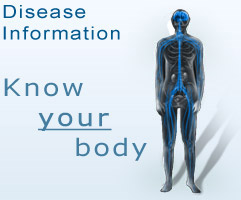Macular Degeneration
What is macular degeneration?
Age-related macular degeneration is a degenerative condition of the macula, the central portion of the retina, which is responsible for sharp vision in the middle of the vision field of the eye. It causes progressive reduction of central vision. In the early stages, vision may be gray, hazy, or distorted.
Macular degeneration is a very common cause of blindness in people over the age of 65, and accounts for approximately 10% of blindness in large population groups.. About 30% of the population over the age of 74 is affected by this condition.
Types of macular degeneration
Dry macular degeneration (atrophic)
The dry type is more common and accounts for 70% to 90% of cases of macular degeneration.
Wet macular degeneration (exudative)
The wet type may cause visual distortion and make straight lines appear wavy. A central blind spot will subsequently develop. The wet type progresses more rapidly and vision loss happens sooner and is more severe. Treatments for the wet type are limited and very expensive.
Causes of macular degeneration
Macular degeneration is part of the ageing process. The patient may have a family history of macular degeneration; which increases the risk of developing it. The condition is slightly more common in females. The Caucasian and Asian population groups are more susceptible to developing macular degeneration.
Other risk factors include smoking and a diet rich in saturated fat. Consumption of moderate amounts of foods rich in vitamin A is associated with a lower risk. It is generally believed that exposure to ultraviolet (UV) light may contribute to the development of the condition, but this has not been proven.
Symptoms of macular degeneration
The main symptom of macular degeneration is a change in the centre of the field of vision. You may also experience:
- blurred central vision, or the appearance of a blank spot on the page while reading;
- visual distortion, e.g. straight lines that appear wavy;
- that images may appear smaller;
- change in colour perception; and
- abnormal light sensations.
These symptoms may occur suddenly and become progressively more troublesome. Sudden onset of symptoms, particularly vision distortion, is an indication that you require immediate evaluation by an ophthalmologist. The ophthalmologist will conduct various tests to determine the diagnosis.
Treatment of macular degeneration
Early detection is important because treatments are available that may halt or slow the progression of wet macular degeneration. There is no effective treatment for dry macular degeneration.
Wet macular degeneration can be treated with laser therapy in some cases. This treatment is effective in about half of all cases, but results may be temporary. Other forms of treatment for the wet type include radiation therapy and photodynamic therapy.
Other therapies under investigation include treatment with biologicals, thalidomide, and other medication that slows the growth of blood vessels. Eye surgery has also shown promise in rapid-onset cases of wet macular degeneration. This surgery carries the risk of retinal detachment, haemorrhage and cataract formation.
Consumption of a diet rich in vitamin A, C and E, selenium and zinc may help prevent macular degeneration, particularly if started early in life. Good dietary sources of antioxidants include citrus fruit, cauliflower, broccoli, nuts, seeds, orange and yellow vegetables, cherries, blackberries and blueberries. Research has shown that nutritional therapy can prevent macular degeneration or slow its progression once established.
Outcomes of the condition
Dry macular degeneration is self-limiting and eventually stabilises, while the loss of vision is permanent. The vision of patients with wet macular degeneration often stabilises or improves even without treatment, at least temporarily. However, after a few years, patients with wet macular degeneration are usually left with only coarse peripheral vision remaining. Many patients with macular degeneration lose their central vision permanently and may be declared blind. However, macular degeneration rarely causes total loss of vision. Vision in the outer limits of the vision fields is retained.
References
NEJM 2006; 355
American Journal of Ophthalmology July 2006; 142(1):10
www.emedicine.com
www.uptodate.com
 TransmedBanner4.jpg)

